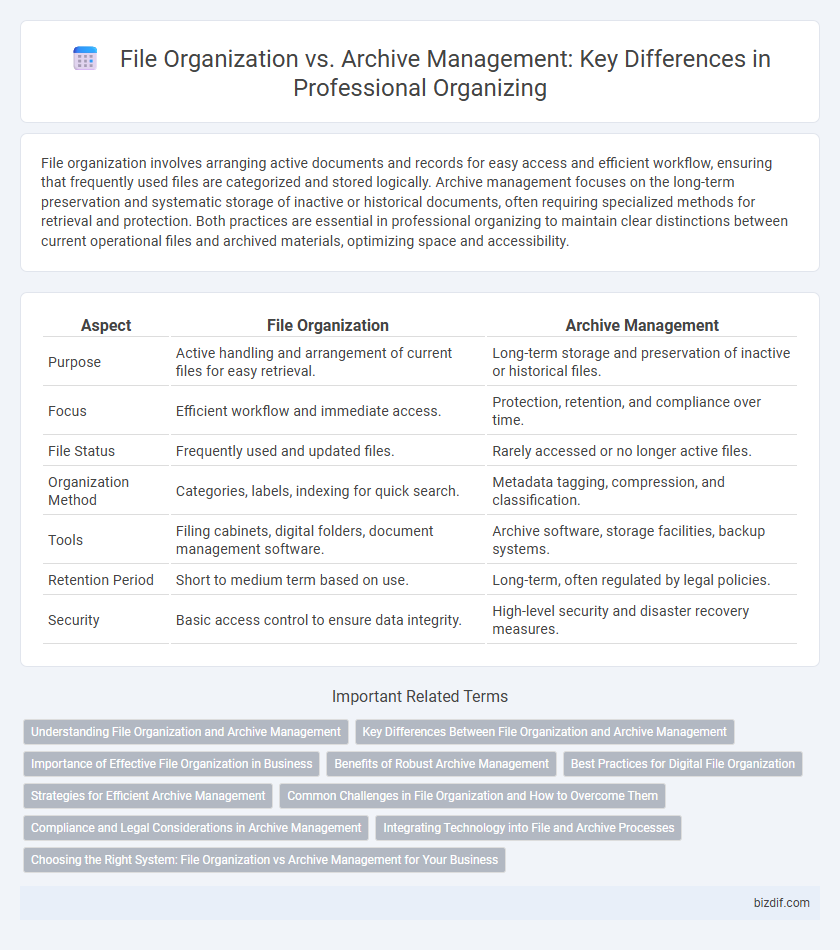File organization involves arranging active documents and records for easy access and efficient workflow, ensuring that frequently used files are categorized and stored logically. Archive management focuses on the long-term preservation and systematic storage of inactive or historical documents, often requiring specialized methods for retrieval and protection. Both practices are essential in professional organizing to maintain clear distinctions between current operational files and archived materials, optimizing space and accessibility.
Table of Comparison
| Aspect | File Organization | Archive Management |
|---|---|---|
| Purpose | Active handling and arrangement of current files for easy retrieval. | Long-term storage and preservation of inactive or historical files. |
| Focus | Efficient workflow and immediate access. | Protection, retention, and compliance over time. |
| File Status | Frequently used and updated files. | Rarely accessed or no longer active files. |
| Organization Method | Categories, labels, indexing for quick search. | Metadata tagging, compression, and classification. |
| Tools | Filing cabinets, digital folders, document management software. | Archive software, storage facilities, backup systems. |
| Retention Period | Short to medium term based on use. | Long-term, often regulated by legal policies. |
| Security | Basic access control to ensure data integrity. | High-level security and disaster recovery measures. |
Understanding File Organization and Archive Management
File organization involves systematically categorizing and storing active documents for easy access and efficient workflow, utilizing methods such as alphabetical, numerical, or chronological filing systems. Archive management focuses on preserving long-term records and historical data, emphasizing secure storage, retrieval, and compliance with legal retention policies. Understanding these distinctions ensures optimized document lifecycle management, balancing immediate usability with long-term preservation.
Key Differences Between File Organization and Archive Management
File organization is the systematic arrangement of active documents and records to facilitate quick access and efficient workflow, typically involving categorization, labeling, and indexing of current files. Archive management focuses on the preservation, storage, and retrieval of historical or inactive records, often emphasizing long-term retention, compliance, and secure protection of valuable information. Key differences include the purpose--file organization supports everyday use, while archive management ensures historical data integrity--and the processes involved, with file organization prioritizing accessibility and archive management centered on durability and legal requirements.
Importance of Effective File Organization in Business
Effective file organization in business enhances productivity by enabling quick access to critical documents and reducing time wasted searching for information. Proper categorization and systematic filing prevent data loss and ensure compliance with legal and regulatory requirements. Maintaining an organized digital and physical filing system supports efficient decision-making and seamless collaboration across teams.
Benefits of Robust Archive Management
Robust archive management ensures long-term preservation and easy retrieval of critical documents, reducing the risk of data loss and improving compliance with legal regulations. Unlike file organization that focuses on everyday access, archive management optimizes storage efficiency and safeguards historical records for future reference. Effective archive strategies enhance workflow by minimizing clutter and supporting systematic categorization of valuable information.
Best Practices for Digital File Organization
Effective digital file organization relies on clear folder hierarchies, consistent naming conventions, and routine maintenance to enhance accessibility and reduce clutter. Leveraging metadata tags and version control systems optimizes searchability and ensures accurate tracking of document updates. Prioritizing secure backups and regular audits prevents data loss and maintains the integrity of active working files.
Strategies for Efficient Archive Management
Efficient archive management involves systematic categorization, metadata tagging, and implementing retrieval processes to ensure long-term preservation and accessibility of records. Integrating digital tools like document management systems enhances searchability and reduces physical storage needs. Establishing retention schedules and consistent audit practices further optimizes archive organization and compliance with regulatory standards.
Common Challenges in File Organization and How to Overcome Them
Common challenges in file organization include misplaced documents, inconsistent labeling, and inefficient retrieval systems. Overcoming these issues requires implementing standardized naming conventions, utilizing digital tools with search capabilities, and regularly purging outdated files to maintain clarity. Emphasizing ease of access and systematic categorization enhances productivity and reduces time lost in locating important information.
Compliance and Legal Considerations in Archive Management
Archive management requires strict adherence to compliance and legal considerations, including retention schedules, privacy regulations, and secure handling of sensitive information. Unlike file organization, which focuses on efficient access and everyday usability, archive management prioritizes maintaining records' integrity for potential audits or litigation. Implementing robust policies ensures legal compliance and protects the organization from penalties related to data mishandling or unauthorized disclosure.
Integrating Technology into File and Archive Processes
Integrating technology into file organization and archive management enhances efficiency by automating metadata tagging, enabling quick retrieval through AI-powered search algorithms, and ensuring secure cloud storage with version control. Advanced document management systems streamline workflows by categorizing active files separately from archived records, facilitating seamless access while maintaining compliance with data retention policies. Leveraging digital tools reduces physical storage needs, accelerates audits, and improves overall data governance across professional organizing practices.
Choosing the Right System: File Organization vs Archive Management for Your Business
Selecting the ideal system for your business requires understanding the distinct roles of file organization and archive management. File organization focuses on the efficient arrangement and easy retrieval of active documents, enhancing daily operational workflow. Archive management involves long-term storage and preservation of inactive records, ensuring compliance and safeguarding historical data for future reference.
File Organization vs Archive Management Infographic

 bizdif.com
bizdif.com